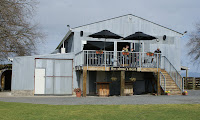 |
| Hobbiton, Matamata, New Zealand |
Having said that, Peter or no, I couldn't have had a better tour guide than Ian Brodie, the official THE LORD OF THE RINGS location guidebooks author. During our leisurely walk around the Hobbiton set, we discussed the effect of THE LORD OF THE RINGS on the now bustling New Zealand film and film tourism industries and the national economy, as well as the unique talent that is Sir Peter Jackson. Be advised that as a condition of my visit, I signed a non-disclosure agreement with Warner Bros, which prevents me from publishing the photographs I took within Hobbiton until after the release of the films in 2012 and 2013.
 |
| Visitor Information, Matamata |
 |
| Along roadside in front of Hobbiton |
Unsurpassed production values and expert literary materialization aside, the financial success of Jackson's franchise has more than trickled down into local economies throughout New Zealand. For example, the country's annual tourist influx jumped from 1.7 million in 2000 to 2.4 million in 2009. Tourism in New Zealand is a $59 million per day industry and, moreover, directly or indirectly employs nearly one in 10 New Zealanders (184,000 total) in full-time equivalent jobs.
 |
| The Shire's Rest Cafe |
 |
| The Wool Shed |
 |
| Roadside in front of Hobbiton |
Hobbiton is also the key set of THE HOBBIT, which is the prequel to THE LORD OF THE RINGS and the story of Bilbo Baggins, whose peaceful life in the Shire is interrupted by a surprise visit from his friend Gandolf the Grey. Like THE LORD OF THE RINGS, which was filmed back-to-back over 274 days, cost $281 million to make, and used 350 purpose-built sets in more than 150 locations all over New Zealand, THE HOBBIT is similarly expected to shoot for the rafters in terms of budget and production infrastructure and locations. The two-part 3D prequel is estimated to cost more than $500 million to make, and (it is hoped) will inject a cool $1 billion into the New Zealand economy.
Part of the rationale for the expected success of the upcoming films is the legion of fans Jackson brings with him from THE LORD OF THE RINGS. The cast of the prequel hasn't changed very much. Elijah Woods will once again play Frodo with Ian McKellan portraying Gandolf. Cate Blanchett will reprise her role as Galadriel, with Andy Serkis providing the voice and movement of Gollum.
The Hobbiton set hasn't change much either. Middle Earth is still lush green rolling hills that house a Party Tree, the Green Dragon, and rows of homes--some small, others smaller yet--with primary-colored circular doors that house our friends Sam Gamgee and Frodo, and the beloved Bilbo, along a curved path from Bagshot Row to Bag End.
Also, the houses along the path are still built to two different scales, so the characters appear to be the appropriate sizes. Frodo Baggins (as well as the average hobbit) is 3' 6" tall, whereas dwarfs are about 4' 6" and elves are five to six feet.
Some of the quintessential sets within Hobbiton are back in the prequel, including the seesaw and Dun-bee Hive, the watering hole, and the large water-wheel behind the old Mill. Similarly, the vegetable gardens still look lush and vibrant throughout the Shire. The Hobbiton groundskeepers where on the premises working during my tour, planting flowers and shrubs. Also extra sheep are grazing the land in preparation for the start of production.
Similarities aside, because THE HOBBIT takes place sixty-five years before THE LORD OF THE RINGS, some set adjustments have been made. For example, the wood carvings in the edging around the doors and windows of the homes throughout Hobbiton are, at once, expertly detailed and appropriately worn. Equally well executed are the scaled-to-height mailboxes and trees, the hobbit-style steps built into the hillside, and the thoughtful arrangement of knickknacks assembled behind the transparent stained glass windows. Even firewood is cut into tiny blocks and assembled into small outdoor enclaves in the front of many Hobbiton houses, as if chopped up and stored by hobbits themselves.
Finally, whether thatched or simply laced, the fences throughout Hobbiton take into account the available materials and level of skills of hobbits who lived 65 years before the time of THE LORD OF THE RINGS. I was especially in awe of the aged moss glued seamlessly to the fences throughout the Shire. At every turn, in fact, I was reminded of the painstaking detail with which Jackson and his design team at Weta Workshop create, and the pride they take in bringing Tolkien's vision to the big screen. I figure they deserve their many accolades and extraordinary box office grosses when a person, such as myself, who makes her living from critically examining the entertainment industries suspends her disbelief long enough to once again become a grateful, gooey-eyed fan of the cinema.
 |
| Brodie (l) and York (r), Shire's Rest Cafe |
